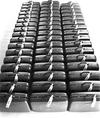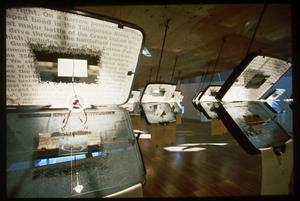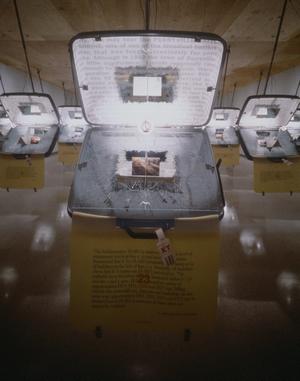
TOURISMS:SUITCASESTUDIES
Tourisms: suitCase Studies is a traveling installation. Its mobility parallels its theme. Concerned primarily with travel to the American past, the project examines the spatial and temporal devices used in the production and sustenance of national narratives through tourism. The installation travels in fifty identical Samsonite suitcases, the suitcase being the irreducibly edited, portable unit of the home. In addition to transporting the contents of the exhibition, the suitcases double as display cases for the exhibition of their contents. Each suitcase is a case study of a single tourist attraction in one of the fifty states in the United States.
The fifty attractions are selected from two types of tourist spots: famous beds and famous battlefields, both sites of conflict. Among tourist attractions, the bed of a public figure and the field of battle most strongly feed the viewer’s yearning for authenticity and abiding interest in the legacy of heroism. Both play subtly in the creation of aura. The vacated bed of the popular figure and the vacated landscape of the soldier are both imbued with presence — a presence, however, that accepts a system of representation as a substitute for immediacy.
Domestic attractions dramatize the hyperprosaic. Upon entering the birth home of a historic figure, for example, the tourist is relegated to peripheral zones of circulation. Permitted only to peer through the door frame, the tourist-cum-voyeur is admitted to an enshrinement of the ordinary. Each artifact placed inside the sanitized field of vision plays a precise role in the narrative reproduction of that public figure. Among the domestic scenes offered for viewing, the bedroom offers the ultimate titillation, the bed being the most private and intensely auratic site.
The battlefield — an otherwise undifferentiated landscape — becomes ideologically encoded through the commemorative function of the marker, which inscribes war onto the soil. Without the marker, a battlefield is virtually indistinguishable from a golf course. Guided by a system of markers and maps, the tourist-cum-strategist reenacts the battle, retracing the tragic path of conflict on foot or in an automobile.
A postcard is cantilevered on edge from the hinge of each suitcase. The back and front surfaces of the cards are obscured from view, revealed only by mirrors set flush with the suitcases’ upper and lower lids. When the postcards are viewed from the front, the mirrors visually delaminate their two surfaces, separating text and image. The tourist’s personal handwritten account is reflected above, floating in front of the site’s official text. The postcard image is reflected below, floating in front of a system of reconfigured maps, drawings, and models that combine information that has been either selectively included in the official narrative or eliminated from it.
Three ordering systems are in play. First, the suitcases are arranged alphabetically by state. Second, the suitcases are located geographically: the upper lid of each case is held open by a cord anchored to its corresponding position on a map of the United States, etched onto the plywood ceiling. Third, the suitcases are ranked economically: each is numbered according to the state’s annual tourism revenue. California marks one extreme, at $36.9 billion, and North Dakota the other, at $1.4 million.
Tourism is an easy object of derision for critics with a deep anxiety about the “debasement”’ of contemporary culture. In the general contempt for tourists, the complex codes and negotiations that guide tourism are typically undervalued or overlooked entirely. Yet tourism is, by definition, theoretical. According to cultural critic Georges Van Den Abbeele, “The distinction between tourist and theorist is all the more difficult to sustain if one remembers that the first definition of the word ‘theory’ cited by the O.E.D. is a ‘sight,’ a ‘spectacle,’ from the Greek theoria.” Anthropologist Dean MacCannell sees the tourist as a metonym for modern man generally, a stand-in for a broader sociological theory of modernism. He notes that “with the exception of existentialism and science fiction, there is no other widespread movement universally regarded as essentially modern.”
Tourisms: suitCase Studies views tourism critically but affirmatively as a tacit semifictional pact between sightseers and sightmakers that incites a delirious free play of space-time, and one that exposes history as a shifting construct. Operating under the assumption that the target and the weapon can be the same, the installation overtly plays out its own role as a tourist attraction.
 Suitcases installed at Walker Art Center
Suitcases installed at Walker Art Center 50 valises
50 valises Photograph of contents of suitcase in Tourisms: suitCase Studies
Photograph of contents of suitcase in Tourisms: suitCase Studies
| Location Walker Art Center, Minneapolis, United States |
| Team | Elizabeth Diller,Ricardo Scofidio,Victor Wong,Christopher Evans,Peter Burns,Robert McAnulty,Christopher Otterbine,Anik Pearson,Johannes Kressner,Charles Stone,David Huang,and Rafael Berkowitz |

